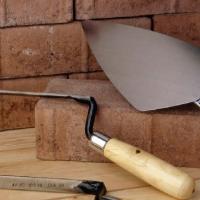Do-it-yourself quick drainage of water from a stretch ceiling. Stretch ceiling flooded: what and how to do? Water is collected in the false ceiling
From the author: hello dear master! The topic of today's article is how to drain water from a stretch ceiling. To the great regret of the neighbors from above, the task is not easy, but solvable. The high-rise building in which you managed to live is not protected by anything from such antics of plumbing and negligent neighbors. But, the stretch ceiling will not let the water go further. And if you see a threatening bubble in the "sky" of your apartment, urgently call the master, or try to fix the problem yourself.
Water in a stretched canvas - what to do? The first and most important thing is to immediately turn off the electricity (water is a conductor), that is, to de-energize all household appliances. Then we call the HOA or whoever is in charge of you - we call the masters who installed the ceilings, and we call them for help. The master installer will most quickly and efficiently eliminate the bubble and restore the ceiling to its original form.
Is self-reliance good?
If you get through, then your problem is solved - but if not? After all, such antics happen, as a rule, on New Year's holidays, a day off, when you cannot find a master. And here there is only one way out: to drain without assistance, with your own hands.
Important rules to consider. Not a liter has accumulated in your ceiling, but a hundred, two hundred, or even more liters of water. Well, you punch a hole, and then what?
Therefore, remove carpets, office equipment. Cover the furniture that you feel sorry for with plastic. Prepare pots, baths, rags. When it rushes, there will be no time to run.
We decide where we will drain the water - the mounting hole for the lamp, or the corner closest to the bubble.
 A source: http://www.tverpotolki.ru
A source: http://www.tverpotolki.ru
It is difficult to assess the volume of "happiness" that has fallen down visually, so we prepare dishes under water with a very large supply. And one more thing: imagine yourself on a stepladder, you open a road, a waterfall for the water, and who will run with rags and buckets? Mobilize the whole family, right up to Sharik. Hands will not be superfluous.
Another mistake: ceiling puncture. It will release a huge mass of water, which, under its own weight, will rush into the resulting puncture, tear it wider than a football goal and that's it. Money down the drain.
And immediately, before it starts, determine the way of draining - by gravity or with a hose.
Procedure for draining water from the ceiling
Let's consider step by step what needs to be done to "free" the stretch ceiling from water:
- We get up on a table-chair, a stepladder. We will stand for a long time, so everything should be stable and reliable, as if forever.
- Devices are de-energized, we remove the lamp. It is through its mounting hole that we will try to drain the accumulated H 2 O.
- Having freed the hole, we visually estimate the scale. If there is a lot of water, then it is worth using a hose.
- We lower one end of the hose into the hole, the other into the prepared container. We drain, squeeze the hose, someone below takes out a bucket, and so on until victory.
 A source: http://potolokspec.ru
A source: http://potolokspec.ru
If there is no mounting hole, use the closest corner. Carefully remove the edge of the material from the engagement, substitute the container, carefully, without haste, lower the edge of the material and forward.
Important: do not smooth the bubble with your hands. The water will scatter along the folds, and then it will also bloom. Mold is even harder to fight. And most importantly, if everything is done correctly, the film will dry out, will itself take on its original state and will delight you with its appearance for many years.
As you can see, it is not at all difficult to drain the water from the stretched panel on your own.
The accident was eliminated, the sealed ceiling was almost not damaged, everyone is happy? No. In the very near future, we are calling the masters to use heat guns to return the ceiling to its former grandeur.
As you can see, the bubble on the ceiling is not the end of the world. Everything can be solved. And the main thing is this: PVC-film is a very durable and plastic material. It does not allow water to pass through at all and holds a huge volume of liquid - even when stretched to the level of the floors, the PVC film will not tear. And therefore, people who survived the "flood" and did not destroy a single thing at the same time will be forever betrayed. If not for him, if for simple plaster ?!
We make a pipe bypass
Speaking about the stretch ceiling, flooding and liquidation of the consequences of flooding, one cannot fail to mention. There are several ways to get this job done. Often, during the installation of the ceiling, an incision is made to bypass the pipe, but not earlier than the edge of the material will be tucked into.

Flood from above
Stretch ceiling structures are not just amazingly beautiful. They are also very practical. These products do not deteriorate under the influence of moisture, and if neighbors flood you from above, then it is enough to simply remove the leaked water from under such ceilings. You just need to know how to drain water from a stretch ceiling, and follow all the recommendations in the correct sequence.
After drying, the material will return to its original shape, so that neither your ceiling nor the furnishings of the room will suffer at all.
Where to expect floods in the house?
It would seem that reinforced concrete floor slabs should not allow any leaks. And yet, water always finds its way, seeping into your ceiling from the upper floors.
And the fact is that slabs in multi-storey buildings are attached to each other with special mounting grooves or with the help of reinforcement joints. No matter how hard the builders strive, they cannot make the joints perfectly sealed.
However, this is a question of quality. construction works in general, because some "workers" do not even try very hard, clogging up the cracks with insulation. And that's the best case. It happens that they are simply filled with construction waste. It is this approach that leads to the fact that water from above penetrates into our apartments almost unhindered.
Usually, moisture begins to ooze around the perimeter of the room, but it can also appear in the center of the room, because cracks in the slabs are also not uncommon. If you install a stretch ceiling in the room, then water will accumulate in its canvas. Over time, the ideal geometry of the ceiling will begin to break down, and it will slowly pull down.
Are all stretch ceilings equally resistant to flooding?
There is an opinion that any tension covering is capable of reliably holding water. This statement is only half true. The fact is that the quality of the materials is of prime importance here. Some canvases, after draining the water, can take the same shape without losing appearance, while others are subject to mandatory replacement.
Features of fabric-based ceilings

Drying the ceiling
In the production of seamless stretch coverings on a fabric basis, fabric is used, which is impregnated with a special polyurethane compound. This substance serves as a waterproof layer for the material. But the effectiveness of such impregnation is highly questionable.
Certainly, fabric ceiling for some time, it will restrain flooding, but water will still seep through the fibers of the material. As a result, you will need to replace the coating. Therefore, you should not risk installing such products in places where the risk of leakage is especially high, for example, in bathrooms or showers.
Features of polyvinyl chloride (PVC) stretch ceilings
The PVC film construction is a great option if you need reliable protection against leaks. The name speaks for itself - a film, which means that all water will accumulate only inside the ceiling, without damaging anything in the room. Your task is to remove the collected liquid in time.
Important! One square meter PVC film is capable of withstanding a 100-kilogram load from the incoming water.
The completeness of the restoration of the shape of the PVC coating will depend only on the volume of leaked water. Most often this happens almost painlessly for a stretch ceiling, which, after drying, initially acquires ideal evenness and beauty.
How to properly remove water from a stretch ceiling - several proven methods

Draining water through the hole of the chandelier
The moisture entering the room gradually stretches the film. A noticeable bubble forms in this section of the structure. Consider how to drain water from a stretch ceiling, especially since its device makes it quite easy to do this using two simple methods.
Important! Before starting to manipulate the ceiling structure, it is imperative to turn off the electricity! Otherwise, you run the risk of putting your health at enormous risk. In addition, remove all household appliances.
The first way to remove water
The water can be drained through the holes provided for the installation of recessed ceiling lamps or chandeliers. For this you need:
- Remove the lighting fixture, under which you will see a PVC ring and a small entrance for installing the lamp.
- By gently pulling back the mounting ring, lift the water bubble and move it towards the hole. Then drain the water into a previously prepared container. To carry out such an operation, you will need the participation of two people.
Second way to remove water

Hose connection to chandelier hole
The liquid can be drained in one of the areas around the perimeter of the room.
Do it like this:
- Remove the skirting board and detach the stretch ceiling film at this point.
- Carefully moving the resulting accumulation of water to the edge of the web, drain it into any suitable container and install the elements of the tensioning structure in place.
After the end of the procedure, to give the film its original shape, dry it with a regular hair dryer. This is a rather painstaking process, but if you want to perfectly restore the ceiling, do the work very carefully.
Attention! Do not forget that during the removal of moisture after flooding, in no case should the coating be pierced or cut! After such an operation, the material will be hopelessly spoiled.
Summary
Of course, the easiest way out in this situation is to call a specialist at home. It will drain the water and then, using a heat gun, restore the perfect surface of the stretch cover.
If you are not confident in your abilities and are not ready to take on all the risks associated with damage to the stretch ceiling and property of the room, invite a professional master. Or do it just for the first time. And then, having looked at the entire technology of the process "live", which, by the way, can be done with the help of video, you will not be afraid to take on the removal of water from the stretch ceiling on your own. Moreover, now you are familiar with all the most important nuances this unpleasant process, from which, by the way, no one is immune.
One of the most popular methods of finishing the ceiling is a stretch fabric, which has a number of advantages, it is easy and quick to install, takes a minimum of time, installation is possible without prejudice to the repairs already made in the apartment. Such a finish leaves behind a minimum of garbage, but the most attractive is the opportunity to emphasize the interior design, to carry out zoning, taking into account the main stylistic idea.
When choosing, one should take into account the factor that neighbors from above can flood, and therefore preference should be given to a durable PVC film that retains water for a long time. Despite the long water retention due to the strength of the material, it is recommended to drain the water from the stretch ceiling as soon as possible. This can be done by calling the specialists who were engaged in the installation or independently, armed with a bucket and a rag.
In most cases, the flood happens unexpectedly and at the wrong time. Unfortunately, it is not always possible to call a specialist to eliminate flooding, since this can happen at a later time, on a weekend or a public holiday. Despite the fact that the canvas is able to retain water for a long time, it is still recommended to act immediately in order to exclude accompanying problems. If the ceiling does not hold water, and it leaks, then the following conclusion can be made - it was produced poorly. If water appears in the stretch ceiling, what should be done first? Necessary:
- turn off the electricity to avoid a short circuit in the wiring;
- move valuables in the form of household appliances to another room;
- cover furniture, especially soft furniture, with plastic bags;
- prepare containers for collecting liquid.
These actions must be performed first. It is also recommended to notify the neighbors, perhaps the water leak has not yet been eliminated, in this case, you should not proceed to draining the water from the ceiling. After the above actions have been completed, you can proceed directly to the actions of draining water from a sagging stretch ceiling.

How to drain water from a stretch ceiling correctly: common common mistakes
It is quite possible to drain the water from the stretch ceiling on your own, especially if the situation is critical or there is no way to wait for the arrival of specialists. The procedure for draining the water itself is not complicated and almost everyone can do it, the main thing is not to do typical mistakes, which will subsequently lead to disastrous consequences and the need to make a complete replacement of the canvas, as well as to repair the floor.
In most cases, a person is not able to correctly assess the volume of water that has accumulated inside. And this must be done as accurately as possible in order to prepare empty containers for collection, otherwise water will simply spill over the room, which already entails other consequences.
Some have a desire to pierce the sagging bladder and drain all the water from there. At first glance, this may seem like the right decision, but even the most insignificant small cut or puncture will lead to the fact that the canvas will immediately burst and all the accumulated water will pour out from there. It is strictly forbidden to pierce the bubble, regardless of its size. In addition, it will no longer be able to protect from water if the neighbors flood the next time.

The correctness of determining the volume of accumulated liquid is very important, since during the draining process there will be no time to look for additional containers, and therefore you should prepare in advance.
Using the mounting ring of the luminaire for draining water from a stretch ceiling

Unfortunately, not all modern stretch ceilings have a special valve in their design, which is used to drain the liquid in case of flooding. In this case, it is necessary to use other methods that will help to simultaneously remove all the water and save the canvas for further use. An excellent solution is to use a mounting ring for, through which all the liquid can be drained.
Important! Before carrying out work, it is necessary to de-energize the apartment to avoid a strong electric shock, since water is a very good conductor of electricity.
To drain the water from the stretch ceiling through the mounting rings installed for the luminaires, you will need additional tools, namely:
- ladder;
- empty containers prepared for water in advance;
- drain hose.
The first thing to do is remove the chandelier or light fixture installed in the mounting ring. Then install a hose into this ring, first, directing its second end into an empty container or bucket. After that, with careful movements, it is necessary to lift the bubble with the accumulated liquid and redirect it to the mounting ring. It will be very difficult for one person to perform such work, since you will need to hold the hose, change the containers under it and direct the water from the bubble to the hole. This procedure will require at least two people. The process of work itself will not cause difficulties, and therefore calling a specialist to eliminate the flood in the presence of a stretch ceiling is not necessary.
Draining water over the edge of the stretch ceiling surface
It also happens that the ceiling sheet does not have special holes for the chandelier. In this case, you can drain through the edge of the canvas closest to the bubble. To perform this procedure, it is advisable to involve assistants so as not to spill water on the floor and not damage the canvas itself. The first thing to do is delete all Decoration Materials from the edge of the canvas, remove the baseboard and masking tape. The next step is to free the edge from the frame as carefully and carefully as possible, it is important to hold the canvas so that water does not spill.
For draining, you can also use a hose by carefully inserting it into the cavity, as an option, you can substitute empty containers directly to the edge of the canvas and thus drain the accumulated liquid. Do not smooth out the bubble too actively with your hands, these actions can lead to the fact that water spreads over the entire surface of the canvas and in the future this will cause dampness and mold formation. The entire procedure must be carried out extremely carefully and slowly so as not to damage the tensioning fabric.

Professional help in drying stretch ceilings after a flood
After flooding, the stretch ceiling sheet is deformed and has an unattractive sagging appearance after all the liquid has been eliminated. Do not despair, it is not at all difficult to return the ceiling to its original appearance with a perfectly flat and smooth surface, however, you will have to seek help from specialists. In most cases, companies involved in the installation of stretch ceilings provide warranty service. If the warranty period has not expired, then you need to contact the company's employees who will dry with special equipment and return a smooth surface to the ceiling.
If the warranty period has already expired or the installation was carried out by masters who do not represent the interests of a particular company, then a professional drying procedure can be ordered from any of the companies that are engaged in the installation of a stretch ceiling. Specialists use special heat guns for drying and leveling the web.

Alternatively, you can try to dry the canvas yourself, using a special building hair dryer or a regular one, turning it on at full power. After heat treatment, the ceiling gets a smooth and even surface, without compromising the appearance and interior design.
Stretch ceiling water drain on video
In the event of a flood and the formation of a bubble on the stretch ceiling canvas, do not despair and panic. It is important to understand that quality installation guarantees water retention for a sufficiently long time. At the same time, you can drain the water yourself without damaging the ceiling. The procedure for eliminating water itself is not complicated, the main thing is to follow the instructions on the video, which clearly demonstrates the whole process of work. But to return it to its original perfectly even appearance, you will need the help of specialists who perform drying using special equipment.
Photos showing the correct drainage of water
After flooding, it is recommended to drain the water as soon as possible. You should not wait for the arrival of specialists, because the whole process takes a little time and is not complicated. The main thing is to involve several assistants in this case. From the photo, you can study in more detail how the whole process of removing water takes place and, following the prompts, perform the same actions. The quality of the stretch ceiling canvases is quite high, and therefore can easily hold large volumes of water. In addition, the canvas can be completely restored and returned to its original appearance, the main thing is not to make typical mistakes that can lead to the need for its complete replacement.

remove the lamp

pushing the hose

pour water into a container

How to organize the drainage of water from a stretch ceiling, and independently, it would be nice to know, just in case, to everyone who invested in expensive repairs. It is impossible to foresee everything, and a flood can happen in any apartment. Substandard water tap, old worn out or defective pipes, unprofessional installation. If the owners are not at home, or they could not eliminate the accident, then the water will flood the floor and flow down, and there a stretch ceiling awaits her. The ceiling material does not allow water to pass through, and this will save your things, furniture and walls from getting wet.
But it is necessary to get rid of the consequences of the flood immediately, as soon as this trouble is discovered. A water bubble on the ceiling is not aesthetically pleasing, and certainly not hygienic, moisture promotes the development of bacteria, and later mold. Water is dangerous because it can get to the electrical wiring and make a short circuit. And if your ceiling has a fabric base, then its waterproof impregnation may not withstand for a long time and leak. So, let's figure out how to drain the water from the stretch ceiling, if necessary.
We call professionals to drain water from a stretch ceiling
If there is water on the stretch ceiling, then you need to call specialists to drain it. Better to call the company that installed the ceiling. As a last resort, any other similar company will be ready to provide a service for draining water from the ceiling.
A qualified team will arrive with necessary equipment and will not only get rid of unnecessary water, treat it with an antifungal agent, but also return the stretch ceiling to its previous shape. There are times when plaster falls off from the main ceiling during the flood. This means that the stretch ceiling will need cleaning and will have to be reinstalled.
What should be done before the arrival of specialists? Turn off the electricity in this room first. Take out things that are at risk of deterioration from water, household appliances, electronic devices. Find out the cause of the flood, you may need to call the emergency team and shut off the water.

How to drain water from a stretch ceiling yourself
Remove water from a stretch ceiling unambiguously better hands specially trained person. But, unfortunately, it is not always possible to call the master to get rid of the water in the near future. The flood happens in the late evening and on holidays. Leaving everything as it is for a few days is also not an option. There is a risk of leaks. Therefore, it is useful to know what you can do yourself. And yet, if the leaked water is hot, it is better not to touch the ceiling, wait for specialists. Canvas from hot water may become fragile, and additional problems will arise as a result of unprofessional action. Keep in mind that even after you have drained the water from the ceiling yourself, you will still have to call specialists in order to return it to its "presentation". After all, water will surely leave stains on the back of the coating and you will not be able to simply wash the stretch ceiling.
At the sight of a bubble of water, many have a desire to pierce the canvas and release the water. Do not do this. Even a tiny hole under the pressure of water will tear the canvas, it will not be possible to restore it later.
Water from a stretch ceiling is most often drained using holes for lighting fixtures.
Get everything you need ready. Firstly, what you will be standing on under the ceiling for quite a long time: a table or a stepladder. Secondly, the water tank. It is quite difficult to accurately determine at a glance the volume of drained water. Therefore, cook containers as much as you can find. In addition, you may need a hose. When there is very little water, then you can do without it.
Remove the lamp. Pull back the mounting ring, place the hose to the hole. Gently direct the water from the bubble towards the opening. Gently lift the bubble with your hands, try to act so that the water does not run all over the ceiling. For the procedure for draining the water, you will need helpers so that, while you are at the top, fill the containers with water at the bottom and then empty them - especially if there is a lot of water.
In addition to the hole for the chandelier, water can be removed by opening the edge of the stretch ceiling. Free the area of the canvas from ceiling plinth or other attachment. Slowly pull back the material by substituting the water container or hose. Gently drain the water to the edge, drain and replace the skirting board.
After removing the water, the canvas must be thoroughly dried, preferably with a building hair dryer. This is a lot of work, and hands will quickly get tired of holding the hair dryer, but without drying, the ceiling may remain wrinkled. To speed up drying, remove all ceiling lights, if present. This will create air movement in the space between the canvas and the ceiling.
Even if you have already got rid of the water on your own, it still makes sense to contact the company and call specialists to process the canvas from possible stains, quickly and thoroughly dry the material and return the ceiling to its original appearance.
Only after the canvas has completely dried can the lamps be returned to their place.
In theory, there is nothing particularly difficult in draining water from the ceiling on your own. But in practice, the success of this operation will depend not only on your hands, but also on the quality of the canvas. Not every canvas is able to restore its former appearance after the flood.
When a flood occurs, everything in the room can be damaged by the water. If a stretch ceiling is installed, then water will not be able to seep through it, and nothing threatens the environment. Those who came across a similar situation, were able to appreciate all the advantages of such ceiling structures. You just need to know, if stretch ceilings are installed - how to drain the water.
Stretch ceiling structures do not have cracks through which water can pass, so it accumulates, forming a kind of bubble that can acquire a huge size. At the same time, a breakthrough of the canvas rarely occurs - despite the fact that the material is rather thin, it can withstand significant weight.
What to do in the event of a flood
If a water bubble forms on the ceiling, then you need to do the following:
- de-energize the room, otherwise the lighting devices located in the structure will pose a danger of electric shock;
- contact the company that installed the tensioning system to eliminate the effects of the flood. The specialists who installed the stretch ceilings will drain the water carefully so as not to damage the furnishings, and will also return the structure to its original appearance.

It is imperative to turn off the electricity, as water is an excellent conductor and, being located near light sources, can injure people in the room.
Preparing to drain the water yourself
It happens that a flood is discovered late in the evening or on a weekend, when stretch ceilings companies are not working. If at such a moment, there is only one way out - to drain the water from the stretch ceiling on your own, until the canvas bursts.

To do this, you need to follow these steps:
- provide for even the worst option, in which water will break through the canvas and flood everything around; therefore, all expensive items and valuables must be removed from the premises;
- cover furniture with foil;
- prepare as many containers for collecting water as possible;
- determine the place to drain: usually use the hole for the lighting fixture, which is closest to the bubble, if it is not there, then one of the corners.
The most common mistakes
When a leak occurs, the stretch ceiling sags, and, despite the fact that the size of the bubble may be different, it is still difficult to determine by eye how much water has collected there. Its volume depends not only on the amount of water, but also on the density of the material. Nevertheless, it is necessary to have a clear idea of how much water has collected, at least in order to know how many empty containers are required. Much more water will be collected than 10 liters. The specialists who installed the ceiling know how much it can withstand, and based on the volume of the bubble, they will determine how much liquid has accumulated. When solving the problem on your own, you need to take into account that running with buckets will not work, so the help of other people is simply necessary.
The main mistake that is made is to incorrectly estimate the volume of collected water.
Also common mistakes include:
- the desire to drain the water from the stretch ceiling using a bubble puncture;
- attempts to drive liquid in the direction of the luminaire opening;
- smoothing the canvas with improvised items.
It is unacceptable to make a puncture in the bubble - even the smallest hole made with a needle will expand under the weight of water, and a gap will appear in the canvas, which is often impossible to eliminate. Thus, the ceiling will become unusable.
How to drain water from a stretch ceiling yourself, see the video for more details:
How to drain the water
If you have filled in a stretch ceiling, you need to decide on the following:
- with a place for draining water;
- with the volume of accumulated liquid to prepare the required amount of dishes;
- with a drain method (naturally or with a hose).

To drain the water, do the following:
- step on a ladder or sturdy table, not forgetting that you will have to stay there for at least half an hour until all the liquid is drained;
- remove a chandelier or lamp, after turning off the electricity in the apartment;
- carefully look into the canvas to determine the amount of accumulated water;
- if there is a lot of liquid, it is better to use a hose - one end of it is inserted into the hole, and the other is lowered into the prepared dish;
- after filling the bucket, the hose is pinched until the assistant delivers the next container.
If there are no lighting devices, then you can drain the water from the stretch ceiling as follows:
- gently release the edge of the canvas in the corner closest to the bubble;
- substitute empty dishes;
- slowly and carefully lower the edge of the canvas to the level of the bottom of the bubble - jerking is unacceptable, since the material is elastic and easily torn;
- controlling the tension, water is poured into a container;
- let the ceiling dry completely.

Do not try to smooth out the bubble as the water will spread all over the ceiling and will be more difficult to drain. Residual water in the future can lead to the appearance of mold and mildew, so the material must definitely dry well.
You can drain the water from the stretch ceiling on your own, but its previous appearance will not be restored by itself. Smoothing the canvas is useless - in order for the ceiling to acquire a perfect look, it must be warmed up with a heat gun, as during installation. Only fabric ceilings will look perfect after draining the water, and those made of PVC film will be covered with folds. So after eliminating the consequences of the flood, you will still have to turn to specialists so that they restore the previous type of structure.

No one is immune from troubles, but if stretch ceilings are installed, there is no threat of leakage. Therefore, there is no need to worry - furniture and all other objects in the room will not be damaged, if, of course, the water is properly drained. Despite the fact that stretch canvases can withstand significant weight well, you still do not need to wait several days for the masters to come. If the flood happened on the weekend, you need to drain the water yourself - there is nothing difficult, but the ceiling and other furnishings of the room will be saved.
 An excerpt characterizing Maklakov, Nikolai Alekseevich
An excerpt characterizing Maklakov, Nikolai Alekseevich The sexiest lips: scientists have calculated the shape and volume of the girls' sponges
The sexiest lips: scientists have calculated the shape and volume of the girls' sponges Signs of oily skin dehydration
Signs of oily skin dehydration Conspiracies for wealth and good luck at home Ritual for financial well-being luck and luck
Conspiracies for wealth and good luck at home Ritual for financial well-being luck and luck Bricklayers - work tools
Bricklayers - work tools Enfilade layout. What is an enfilade. Is any row a suite
Enfilade layout. What is an enfilade. Is any row a suite How to start repairing an apartment with your own hands
How to start repairing an apartment with your own hands